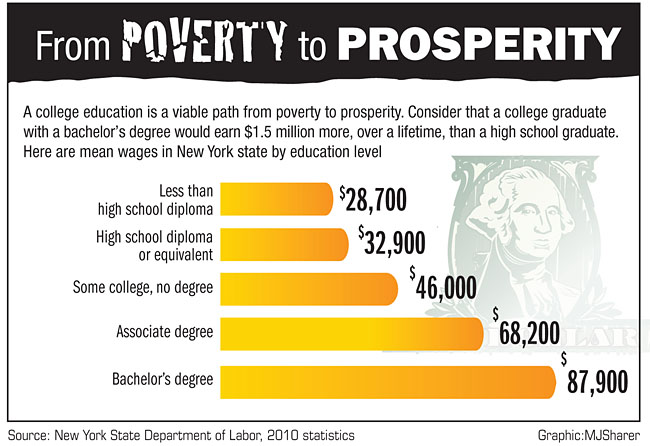When considering economic privilege and inequity, baseball is an apt metaphor. The wealthy start the game at third with the bases loaded, needing only a solid hit to reach home and a future cushioned by privilege. Waiting at second and first are the middle class, with a more difficult path, but home plate still within reach. Buried in the lineup are the poor. For them, crossing home plate is no guarantee.
This inequality is starkly evident in higher education, where soaring costs, shrinking financial aid and underfunded educational opportunity programs have made earning a college degree increasingly difficult. Many students from low-income backgrounds work hard to get into college. But staying often poses an even bigger challenge.
"Somewhere between 50 and 60 percent of our students' family incomes are under $30,000 annually," said Michael Fabricant, a Hunter College professor and treasurer for the Professional Staff Congress, representing faculty and staff at the City University of New York.
Living in poverty, or on the cusp of poverty, puts students in an untenable position — either work several jobs to afford tuition, take on student loan debt, or attend college part-time since full-time attendance is unaffordable, all of which can impede success.

State support dwindling
State funding for the State University of New York and CUNY has fallen significantly over time. In 2000, nearly 60 percent of SUNY and CUNY operating budgets were state funded. More than a decade later, these percentages have flip-flopped, with about 40 percent of funding for SUNY and 51 percent for CUNY coming from the state. NYSUT lobbied hard for higher education funding this year in partnership with its higher education locals — gaining an additional $30 million for community colleges, and $1.2 million for childcare at SUNY and CUNY campuses — but it's simply not enough.
Since 2008, overall state funding for SUNY, CUNY and community colleges has fallen roughly $1.7 billion.
And despite tuition increases, Tuition Assistance Program grants — New York state's main financial aid grant program for students — have remained fixed for more than 10 years at a maximum of $5,000 annually for up to eight semesters.
Tuition outpacing TAP grants has "students clamoring for work-study hours their first semester of college," said Marc Dearstyne, a senior program counselor for SUNY Cortland's Educational Opportunity Program and co-chair of United University Professions' EOP committee. UUP represents academic and professional faculty at SUNY. EOP provides funding and advisement for promising, economically disadvantaged students.
While a willingness to work is a positive quality, it's not the best choice for a first-semester freshman trying to adjust to college life, said Dearstyne, who worries many will find the pressure overwhelming.
"We believe accessible, affordable higher education is a right — a civil and human right and our state leaders should be ensuring that right to all students," said UUP President Fred Kowal. "We don't want to see the system transformed into a place that is less accessible to poor and working class families."
Making tough choices
Sometimes poverty's impact is not always evident in the classroom. "We have students who have to choose between subway fare and lunch, and that come from homeless shelters," said PSC President Barbara Bowen, who objects to rating colleges based on student outcomes, when little is done to address poverty.
"The skills students come in with are dramatically different, depending on where they come from economically," she said. "A commitment to equality of opportunity starts with a commitment to ending poverty."
That commitment is evident at Suffolk Community College, which offers food pantries at all of its campuses to help students make ends meet, said Kevin Peterman, president of the Faculty Association of Suffolk Community College. "We want to help students stay in college," said Peterman. "Many of them are living on the edge."
Ellen Schuler Mauk, chair of the NYSUT Higher Education Committee and a NYSUT Board member, agrees.
"People consider community colleges inexpensive compared to other colleges, but often tuition is still unreachable for students," said Schuler Mauk, FASCC past president.
"Without food pantries, scholarships and grants, many wouldn't be able to come to us."
Even for the best students, the lingering effect of poverty makes transitioning to college difficult. "Many students come from homes where they haven't been taught human-capital skills," said Charles Clarke, president emeritus of the Faculty Association of Monroe Community College, and a psychology professor.
For low-income students, many of whom are the first in their families to attend college, navigating the channels of higher education can be challenging. They often lack guidance at home, and access to campus advisement is falling due to flat funding. "If you have a counselor who needs to help 200 students, some students get lost in the cracks," Clarke said.
Leveling the playing field for all college students won't be easy, but NYSUT is committed to fighting for increased higher education funding, said Maria Neira, NYSUT vice president. Education costs money, but no investment offers New York state more economic, cultural and intellectual benefits. "Making higher education a priority in New York state begins with providing the funding for it," said Neira. "We can't continue the current trend of disinvestment if we hope to compete in the global economy. It's time for the state to get its priorities straight, and make the needed investments in our higher education system."